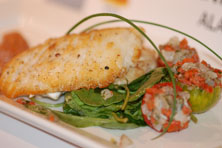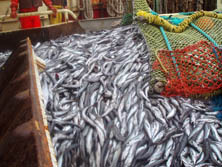Pacific Whiting (Hake) (Mercluccius productus)
- Population levels of Pacific whiting are high, and no overfishing is occurring.
- Strict federal and international management measures successfully completed the rebuilding of Pacific whiting in 2004. Current management measures include annual quotas to limit catch.
- Whiting is a good source of selenium, vitamin B, magnesium, and protein. For more information, see Nutrition Facts. (USDA)
- Pacific whiting is harvested under international agreements by Canadian and U.S. fishermen.
|
 |
 |
 |
 |
| Nutrition Facts |
| Servings 1 |
| Serving Weight
100g |
 |
| Amount Per Serving |
 |
| Calories 177 |
 |
| Total Fat |
8.23g |
 |
| Total Saturated Fatty Acids |
1.959g |
 |
| Carbohydrate |
0.49g |
| Sugars |
0.11g |
| Total Dietary
Fiber |
0g |
 |
| Cholesterol |
47mg |
 |
| Selenium |
57.8mcg |
 |
| Sodium |
494mg |
 |
| Protein |
23.8g |
 |
|
 |
 After years of negotiations, the U.S. and Canada sign an agreement in Seattle, Washington on November 21, 2003, that resolves a long-standing dispute between U.S. and Canadian fishermen over sharing the valuable marine resource. After years of negotiations, the U.S. and Canada sign an agreement in Seattle, Washington on November 21, 2003, that resolves a long-standing dispute between U.S. and Canadian fishermen over sharing the valuable marine resource.
|
 |
Did you know?
Of the 80+ species managed under the Groundfish FMP, whiting landings are the largest single-species landings by volume.
Whiting is primarily used in manufacturing surimi, a processed fish flesh that is the basis for artificial crab and shrimp.
Pacific whiting is not targeted by recreational fishermen; almost all recreational catch is made incidentally to salmon and groundfish fishing.
|
|
| |
 |
|
Pacific whiting is currently the most abundant commercial fish species on the U.S. West Coast. While whiting is most commonly used in the manufacturing of surimi, the production of whiting fillets has recently been increasing.
|
 |
|
Pacific whiting is a roundfish like cod.
|
|
Sustainability Status
Biomass: Biomass of the coastal stock is 95% of the biomass needed to support maximum sustainable yield (BMSY).
Overfishing: No
Overfished: No
Fishing and habitat: There are few habitat concerns in the Pacific whiting fishery, given that pelagic trawls have very little bottom habitat impact.
Bycatch: Pelagic trawls must have a codend mesh of at least 3 inches to prevent bycatch. Regulations also restrict the area and season of fishing to reduce the bycatch of Chinook salmon, canary rockfish, darkblotched rockfish, and widow rockfish.
Aquaculture: There is currently no aquaculture production of Pacific whiting in the United States.
|
Science and Management
Pacific whiting supports one of the most important commercial fisheries off the West Coast of the United States. There are three recognized stocks of Pacific whiting: a highly migratory offshore (or coastal) stock that ranges from southern Baja California to Queen Charlotte Sound, a central-south Puget Sound stock, and a Strait of Georgia stock. The latter two stocks are managed by state and local management agencies, but the offshore, or coastal, fishery in U.S. waters is managed by the Pacific Fishery Management Council (PFMC) through its Pacific Coast Groundfish Fishery Management Plan (FMP). Originally approved in 1982, the Groundfish FMP now manages over 90 different species through a number of measures, including harvest guidelines, quotas, trip and landing limits, area restrictions, seasonal closures, and gear restrictions (like minimum mesh size for nets). Annual quotas are the primary management tool used to limit the catch of whiting. In 1994, Amendment 6 to the Groundfish FMP established a limited entry program to restrict further participation in the groundfish fishery. All sectors of the groundfish fishery are currently constrained by the need to rebuild the groundfish species that have been declared overfished; because of the low biomass of some species, the overall groundfish harvest has been significantly reduced. Pacific whiting was declared overfished by the U.S. government in 2002. The stock was declared rebuilt and no longer depleted in 2004. The coast-wide (U.S. and Canada) Pacific whiting stock is assessed annually by a joint technical team of scientists from both countries.
In 2003, the United States and Canada signed an agreement that allocates a set percentage of the Pacific whiting catch to American and Canadian fishermen over the next decade and established a process for the review of science and the development of management recommendations. Beginning in late 2007, management of Pacific whiting and related science activities will be coordinated under the provisions of this international treaty with Canada.
The local and state-managed Puget Sound and Strait of Georgia stocks are "species of concern" - species that NMFS has concerns about regarding population status and threats but has insufficient information to indicate a need to list the species under the Endangered Species Act. There has been no directed commercial fishery for this stock since 1991.
|
Life History and Habitat
Life history, including information on the habitat, growth, feeding, and reproduction of a species, is important because it affects how a fishery is managed.
- Geographic range: Pacific whiting are distributed off the west coast of North America from Southern Baja California and Gulf of California to the Gulf of Alaska. The coastal stock of Pacific whiting primarily ranges from southern California to the Queen Charlotte Islands. Commercially harvestable quantities of whiting are not available in the Gulf of Alaska.
- Habitat: Pacific whiting occur primarily in midwater schools, but have also been observed resting on the seafloor. The highest densities of Pacific whiting are usually at depths between 164 and 1,640 feet, but adults occur as deep as 3,018 feet and as far as 250 miles offshore.
- Life span: Up to 15 years.
- Food: Pacific whiting feed near the surface late at night and early in the morning. Larvae eat calanoid copepods (crustaceans), as well as their eggs and larvae. Juveniles and small adults feed on euphausiid shrimp. Adult Pacific whiting feed on on euphausiids, shrimp, squid, schooling fish, and sometimes juvenile whiting. As whiting grow larger, they become increasingly piscivorous (fish-eating).
- Growth rate: Females grow more rapidly than males after 4 years; both sexes stop growing at 10 to 13 years.
- Maximum size: Up to 36 inches in length.
- Reaches reproductive maturity: Females mature at 3 to 4 years of age (13 to 16 inches in length), and nearly all males are mature by 3 years of age (11 inches in length).
- Reproduction: Pacific whiting eggs are fertilized externally. Eggs hatch in 5 or 6 days, and within 3 to 4 months, juveniles grow to 1.4 inches. Juveniles move to deeper water as they get older.
- Spawning season: From December through March, peaking in late January.
- Spawning grounds: Off south-central California. However, in recent years spawning has also been recorded north of California as well as unusual numbers of juveniles.
- Migrations: Pacific whiting school in deep waters during the day and then move to the surface and disband at night to feed. After spawning in the winter, mature adults move northward and inshore following food supply and currents. Pacific whiting reach as far north as southern British Columbia by fall. Then they migrate south to spawning grounds further offshore.
- Predators: Whiting eggs and larvae are eaten by pollock, herring, invertebrates, and sometimes Pacific whiting. Juveniles are eaten by lingcod, Pacific cod, and rockfish species. Predators of adults include sablefish, albacore, pollock, Pacific cod, marine mammals, soupfin sharks, and spiny dogfish sharks.
- Commercial or recreational interest: Commercial
- Distinguishing characteristics: Pacific whiting is a roundfish that is silvery in color with black speckles on the back and black inside the mouth.
|
Role in the Ecosystem
Pacific whiting are an important prey item for sea lions, toothed whales, and sharks.
|
Additional Information
Market names: Whiting or Pacific whiting
Vernacular name: California hake, Pacific hake
Several other species are marketed as Whiting.
|
Biomass
 Biomass refers to the amount of Pacific whiting in the ocean. Scientists cannot collect and weigh every single fish to determine biomass, so they use models to estimate it instead. These biomass estimates can help determine if a stock is being fished too heavily or if it may be able to tolerate more fishing pressure. Managers can then make appropriate changes in the regulations of the fishery. Biomass refers to the amount of Pacific whiting in the ocean. Scientists cannot collect and weigh every single fish to determine biomass, so they use models to estimate it instead. These biomass estimates can help determine if a stock is being fished too heavily or if it may be able to tolerate more fishing pressure. Managers can then make appropriate changes in the regulations of the fishery.
Stock biomass of Pacific whiting increased to a high in 1987 due to exceptionally large 1980 and 1984 year classes. Stock size stabilized briefly between 1995 and 1997 but then declined continuously to its lowest point in 2001. Since 2001, stock biomass has increased substantially, as a strong 1999 year class entered the population. The stock has been rebuilt to its target level of abundance.
Note: Age 3+ biomass is shown in the graph.
Landings
 Landings refer to the amount of catch that is brought to land. From 1966 to 2006, U.S. landings of Pacific whiting have averaged 162 thousand metric tons, with a low of 90 thousand metric tons in 1980 and a peak harvest of 360 thousand metric tons in 2006. Prior to 1989, U.S. catches were substantially below the harvest guideline, but since then, the entire harvest guideline has been caught nearly every year. The total U.S. catch has not significantly exceeded harvest guidelines, indicating that in-season management procedures have been very effective. Landings refer to the amount of catch that is brought to land. From 1966 to 2006, U.S. landings of Pacific whiting have averaged 162 thousand metric tons, with a low of 90 thousand metric tons in 1980 and a peak harvest of 360 thousand metric tons in 2006. Prior to 1989, U.S. catches were substantially below the harvest guideline, but since then, the entire harvest guideline has been caught nearly every year. The total U.S. catch has not significantly exceeded harvest guidelines, indicating that in-season management procedures have been very effective.
On average, the United States has caught almost 75% of the total landings over the time series, with Canadian catch averaging about 25% of the total landings, at 54 thousand metric tons.
Note: Only domestic commercial landings are shown in the graph.
Biomass and Landings
 Are landings and biomass related? Landings are dependent on biomass, management measures in the fishery, and fishing effort. Are landings and biomass related? Landings are dependent on biomass, management measures in the fishery, and fishing effort.
Data sources:
Biomass and landings from the Stock Assessment of Pacific Hake (Whiting) in U.S. and Canadian Waters in 2007
|
Important Dates
1966-1979 – Catch in U.S. waters averages 137,000 tons per year
1991 – All foreign and joint-venture participation in the groundfish fishery ends
1994 – Amendment 6 to the Groundfish FMP establishes a license limitation program (limited entry)
2003 – U.S. and Canada sign an agreement allocating a set percentage of the Pacific whiting catch to American and Canadian fishermen over the next decade
|
Notes and Links
General Information:
Pacific Fishery Management Council Primer on Groundfish
NMFS Office of Protected Resources - Species of Concern
NMFS Northwest Regional Office Groundfish Fishery Management page
Fishery Management:
Pacific Coast Groundfish Fishery Management Plan
NMFS Northwest Regional Office - Whiting Fishery Management
Stock Assessments:
Biomass from Stock Assessment of Pacific Hake (Whiting) in U.S. and Canadian Waters in 2007
2007 Report of the Joint Canadian and U.S. Pacific Hake/Whiting Stock Assessment Review Panel
|
| |
|



